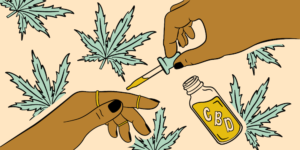
India has used cannabis for more than 2,000 years. (Shiva, one of the main gods in Hinduism, is referred to as the “Lord of Bhang). The ancient medicinal text Sushruta Samhita suggests cannabis plant extract for the treatment of respiratory conditions and diarrhoea.
Even though cannabis is yet to completely legalize, its pervasiveness is still striking across India’s social and spiritual environment. A variation known as “bhang” is commonly used and offered at celebrations.
According to the Vedas, Cannabis was one of five sacred plants, no doubt, it is still considered a sacred and wonder plant!
How well do you know Cannabis?
Cannabis and Cannabinoids
People often are confused about everything related to Cannabis, Hemp, and Cannabinoids because of which they end up mixing all of them even though they differ from each other. (Be it their physical appearance, or existing chemical compounds).
All items made from the Cannabis sativa plant are referred to as “cannabis” products. The cannabis plant alone contains about 540 chemical substances. The four major compounds that have received the most attention are d-9-THC, CBD, d-8-THC, and cannabinol.
Cannabis sativa plant components or byproducts that have high tetrahydrocannabinol concentrations are referred to as “marijuana” (THC). Whereas, may extract CBD from hemp or marijuana.
However, the part where they differentiate is, that for hemp to be legal its THC content should be 0.3 percent or below.
The primary psychoactive ingredient in cannabis, THC, is what gives users a “high.”. Additionally, it comes in tinctures, capsules, foods, oils, and other forms. A consumer usually prefers smoking it.
Both these compounds interact with your body’s endocannabinoid system, but their effects are quite different, depending on their THC content.
Types Of Cannabinoids
Out of all present 480 different compounds only about 66 of the plant’s compounds are known as cannabinoids.
The main psychoactive ingredient in cannabis is delta-9-tetrahydrocannabinol (9-THC), which is considered illegal in India and many other states. However, it is also legal in some states abroad.
However, the component that is considered (partially) legal is Cannabidiol (CBD), accounting for roughly 40% of the plant resin extract.
Cannabinoids are classified into the following groups:
- Cannabigerol (CBG)
- Cannabichromene (CBC)
- Cannabidiol (CBD)
- Tetrahydrocannabinol (THC)
- Cannabinol (CBN)
- Cannabinodiol (CBDL)
- Cannabinoids such as cannabicyclol (CBL), cannabielsoin (CBE), and cannabitriol are also present (CBT)
Medical Advantages - CBD
CBD interacts with neuroreceptors in your endocannabinoid system, which sends signals between your cells to help regulate your movement, mood, homeostasis, and immune system when applied topically or consumed or edible consumption.
In fact, of the 60% of U.S. adults who report having used CBD before, 55% of them use CBD oils and tinctures specifically, according to a recent Forbes Health survey of 2,000 U.S. adults.
The FDA approved Epidiolex, the first prescription medication containing CBD, in June 2018. It is used to treat rare, difficult-to-control epileptic seizures.
- Some of CBD’s anti-inflammatory and antioxidative properties may be able to reduce risk factors that can lead to heart disease, like high blood pressure. It may also be able to reduce the risk of related conditions, like stroke.
- There is anecdotal evidence to suggest that some people with arthritis who use CBD report noticeable pain relief, improved sleep, or reduced anxiety.
- CBD, interact with receptors that influence pain and inflammation in the body.
- Muscle spasms are one of the most common symptoms of MS. These spasms can be so strong they cause constant pain in some people. CBD oil could reduce the levels of muscle spasms a person feels.

The Difference
Cannabinoids are differentiated on the basis of their THC content. In India, the lower, the better!
The compounds CBG, CBC, and CBD are not known to be psychoactive agents, whereas THC, CBN, CBDL, and some other cannabinoids have varying degrees of psychoactivity.
According to scholars and research conducted CBD is the most abundant cannabinoid, as it is thought to have anti-anxiety properties, counteracting the psychoactive effects of THC.
Molecular Structure: 1 carbon atom, 30 hydrogen atoms, and 2 oxygen atoms.
CBD and THC are both chemically related to the human body’s endocannabinoids, enabling the compounds to communicate with your cannabinoid receptors.
The reason why CBD is scientifically considered a cure above all is that CBD has been shown to alleviate anxiety, depression, and seizures. (Refer to our previous blogs).
























